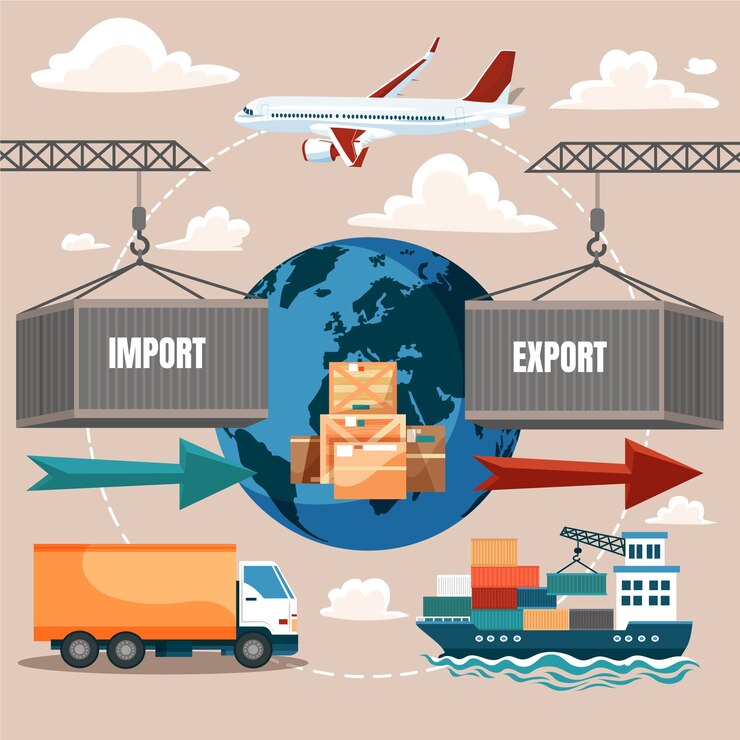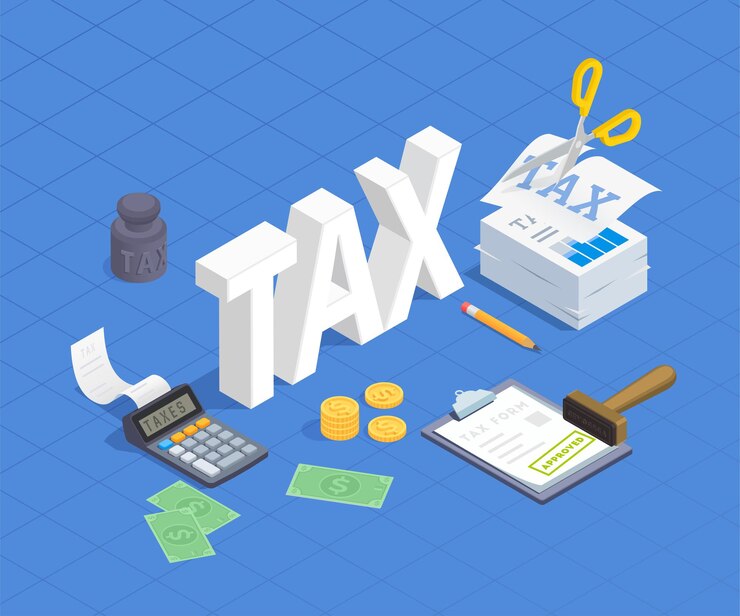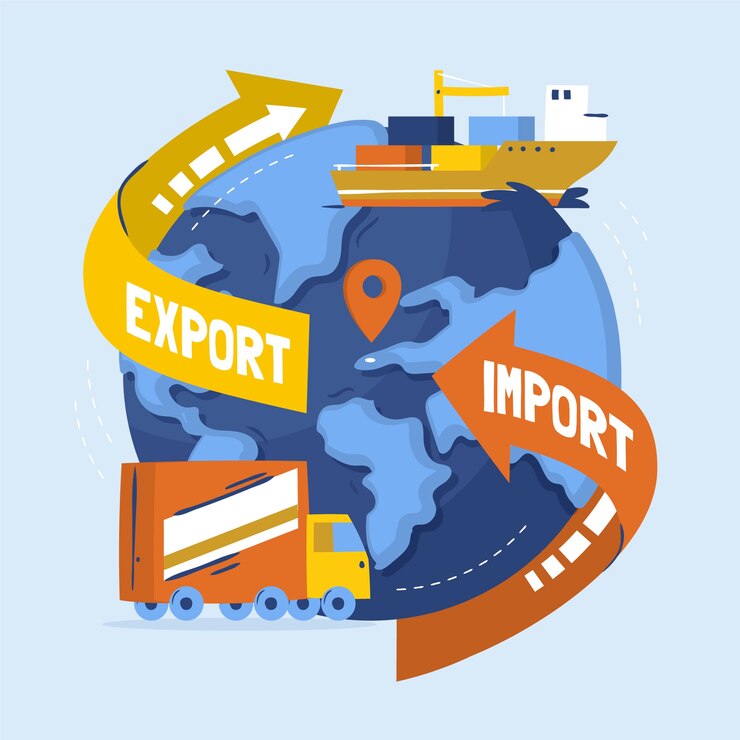A Guide on Import and Export Under GST
- 8 Aug 24
- 17 mins

A Guide on Import and Export Under GST
Key Takeaway
- GST has streamlined the taxation of imports and exports in India, introducing IGST on imports and allowing zero-rated supplies for exports.
- The introduction of GST eliminated the cascading effect of taxes, merging multiple central and state taxes into a unified tax system.
- Exports under GST are treated as zero-rated supplies, enabling exporters to claim refunds on the input tax credit or pay IGST for a refund.
- The E-Way Bill system under GST mandates digital tracking of the movement of goods, applying to both domestic transactions and import-export activities.
- E-invoicing under GST enhances the efficiency of tax administration for imports and exports, ensuring faster clearance and compliance.
Import and Export Under GST
The GST Act says that "imports" are when things and/or services come into India from somewhere outside of India. When goods or services are imported, they become part of the state's economy. This means they are subject to the Integrated Goods and Services Tax (IGST) and any customs fees that are due.
"Exports," on the other hand, are the sending of things and/or services from India to a place outside of India. Under GST, exports are considered zero-rated supplies. This means that exporters can either give goods without paying IGST (under a bond or Letter of Undertaking) and get a refund of the Input Tax Credit (ITC), or they can pay IGST and get a refund of it.
India's Taxation System
Before GST
India's tax system was a complicated mix of different taxes levied by the national government and the state governments before GST. It was common for these taxes to go over one another, which is called "tax on tax." These were the main taxes:

There are several types of central taxes, such as the Central Excise Duty, the Services Tax, the Additional Customs Duty (CVD), and the Special Additional Duty of Customs (SAD).
For example, the State Value Added Tax (VAT), the Central Sales Tax (which is set by the Central Government but collected by the States), the Octroi and Entry Tax, the Luxury Tax, and the Entertainment Tax are all state taxes.
Numerous taxes made the tax system complicated, which caused waste and higher prices for the end consumer as taxes affected other areas.
After GST
GST was made to cover all indirect taxes on the production, sale, and use of goods and services in India. It includes almost all indirect taxes at the national and state levels. It's a single tax from the manufacturer to the buyer that is credited at different stages to cancel out taxes paid at earlier stages. This stops the effect of the tax going up and down. The GST system's most important parts are:
Unified Tax Structure: GST combined several central and state taxes into a single tax scheme. This made it easier to follow the tax rules and made the tax structure simpler.
Goods and services are charged at different rates under GST. These rates are mostly broken down into four slabs: 5%, 12%, 18%, and 28%. Some basic goods are also taxed at 0% to make sure that everyone can buy them. On the other hand, luxury and sin goods may be subject to higher GST rates. In some cases, a cess is also charged on top of the 28% GST rate to help with social welfare issues.
Dual GST: India switched to a Dual GST plan, which includes IGST (Integrated GST), SGST (State GST), and CGST (Central GST). When you buy something within a state, you have to pay CGST and SGST, which are split between the center and the state.
Input Tax Credit: GST added a full input tax credit system that lets businesses collect credits for the taxes they paid on inputs and use those credits to pay taxes on the output. This method makes the effect of taxes much less of a domino effect.
Digital Compliance: GST also took a digital-first approach by creating the GST Network (GSTN) for filing returns, making payments, and registering companies. This made things more clear and made it easier to do business.
💡If you want to pay your GST with Credit Card, then download Pice Business Payment App. Pice is the one stop app for all paying all your business expenses.
How are imports and exports taxed under GST?

Imports
Import of goods
The tax consequences of importing services are the same as those of importing things under GST. IGST is charged at the rate that is right for each service that is brought in. Based on the rules of the place of supply, the service is taxed, and in India, the person who receives the service has to pay the tax using the reverse charge method (RCM).
So, the Indian person who receives the service, not the foreign seller, is responsible for paying GST. This makes sure that services brought into India are taxed the same way services are taxed in India.
Import of services
The import of services under GST is treated similarly to the import of goods in terms of tax implications. IGST is levied on the import of services at the rate applicable to the specific service. The place of supply rules determine the taxability of the service, and the recipient of the service in India is required to pay the tax under the reverse charge mechanism (RCM).
Therefore, Indian recipient of the service, rather than the foreign supplier, is liable to pay GST, ensuring that services imported into India are taxed in a manner similar to the supply of services within India.
Exports
Exports are treated as zero-rated supplies under the GST regime. This means that no GST is charged on the export of goods or services, making Indian exports more competitive in the international market. Exporters have two options for shipping goods or services:
- Without Payment of IGST: Exporters can export goods or services under a bond or Letter of Undertaking (LUT) without paying IGST. They can then claim a refund of the input tax credit on the goods or services exported.
- With Payment of IGST: Alternatively, exporters have the option to pay IGST on their exports and then claim a refund of the IGST paid. This option ensures that the exporter does not bear the burden of the tax, as they are reimbursed for the taxes paid once the goods or services are exported.
The zero-rating of exports under GST ensures that exported goods and services are not subject to double taxation, as they would not be taxed in the destination country under international tax treaties and agreements. This system is crucial for maintaining the competitiveness of Indian exports in the global market by ensuring that taxes do not add to the cost of exported goods and services.
GST E-Way Bill
The GST E-Way Bill, which stands for "Electronic Way Bill," is an important part of India's things and Services Tax (GST) system. It was created to control how things move across the country, including supply between states. It is a digital record made on the GST portal that shows the movement of things worth more than a certain amount.
The E-Way Bill method is meant to make sure that all goods being shipped follow GST law. It also makes it easier to keep track of where goods are at all times, which cuts down on tax evasion and makes the supply chain more open.
What is the applicability of e-way bill on import and export transactions?
Businesses that deal with other countries need to know if the E-Way Bill can be used for import and export transactions in India that are subject to the Goods and Services Tax (GST) regime. The E-Way Bill is a digital record that is needed to move goods worth more than a certain amount.
It can be used for both importing and exporting goods and services, making sure that GST rules are followed and making it easier to clear customs when importing.
Applicability on Imports
In order to bring goods into India, you need an E-Way Bill once the goods have passed customs and are being moved from the customs station to their final destination within India. The importer or transporter is in charge of making the E-Way Bill so that the goods can move on within Indian land. This is very important because the goods are now thought to be in transit under GST rules, and the movement must be recorded as required by GST rules.
When making an E-Way Bill for goods, the Bill of Entry number and date are very important information that must be included. The IGST paid when the goods pass through customs is added to the value of the goods. This makes sure that imported goods follow GST rules when they reach the local market.
Applicability on Exports
The E-Way Bill is also important for trade. The seller needs to make an E-Way Bill so that the goods can be moved from their business to the port, airport, or land border where they will be sent abroad. After getting this paperwork, the things can move around inside of India until they reach the point where they leave the country.
When goods are exported, the E-Way Bill has information about them, like the name of the exporter, the GSTIN, the place where they are going, and other important information. The value listed on the E-Way Bill for exports is the same as the value listed on the shipping bill or bill of export. This makes sure that all the paperwork is the same for GST and customs reasons.
How to generate e-way bill for imports and exports?

Generating an E-Way Bill for imports and exports is a critical step in ensuring compliance with the Goods and Services Tax (GST) regulations in India. The process involves the use of the GST portal and requires specific details depending on whether the goods are being imported into India or exported from India.
Here’s a step-by-step guide on how to generate an E-Way Bill for both imports and exports:
For Imports:
- Access the GST Portal: Start by logging into the GST portal.
- Navigate to E-Way Bill System: Once logged in, navigate to the E-Way Bill system by selecting the option to generate a new E-Way Bill.
- Enter Details in Part A: For imports, the E-Way Bill generation process begins with filling out Part A. This includes:
- The GSTIN of the recipient (importer).
- The place of delivery.
- The invoice or bill of entry number and date.
- The value of goods (which should include the Customs Duty and IGST paid).
- The HSN code of the goods.
- The reason for transportation (which would be 'Import' in this case).
- The transport document number (Bill of Lading/Airway Bill).
- Complete Part B: Part B requires the details of the transporter. This includes the vehicle number that will carry the goods or the transporter ID if the transportation is being handled by a third-party logistics provider.
- Submit to Generate E-Way Bill: After filling in all the required details, submit the form to generate the E-Way Bill. The system will provide an E-Way Bill Number (EBN), which should be used for all future references to this particular movement of goods.
For Exports:
- Log into the GST Portal: As with imports, the process starts on the GST portal.
- Select E-Way Bill Generation: Choose the option to generate a new E-Way Bill within the portal.
- Fill in Part A Details: For exports, Part A must include:
- The GSTIN of the exporter.
- The place of dispatch.
- The invoice or shipping bill number and date.
- The value of goods.
- The HSN code.
- The reason for transportation (which would be 'Export' in this case).
- The destination country.
- The transport document number (which could be the Bill of Lading or Airway Bill number).
- Complete Part B: This involves entering the vehicle number that will transport the goods to the port, airport, or land border or the transporter ID.
- Generate the E-Way Bill: Submit the completed details to generate the E-Way Bill, and note the EBN provided by the system.
Is E-Way bill required for high sea sales?
Indian Goods and Services Tax (GST) rules say that sales over the sea must have an E-Way Bill before they can happen. High sea sales (HSS) are when the consignee sells goods to another buyer while the goods are on the high seas or after they have been sent from the port of origin but before they clear customs in the target country, in this case India.
In high sea sales, an E-Way Bill is needed when the goods are being moved from the customs station to the buyer's place of business after they have been cleared by customs. As per GST rules, an E-Way Bill needs to be made because the transaction includes moving goods within the country after they have been cleared by customs. How it works:
- After Customs Clearance: Once the goods involved in high sea sales are cleared by customs, they are considered for domestic movement within India, making the generation of an E-Way Bill mandatory for their transportation to the buyer's place of business or any other specified destination.
- Who Generates the E-Way Bill: The responsibility for generating the E-Way Bill typically falls on the buyer in the high sea sales transaction, as they are now the recipient of the goods. The buyer must ensure that the E-Way Bill is generated before the movement of goods commences from the customs station to the designated place.
- Details Required: For generating an E-Way Bill in the context of high sea sales, the buyer needs to include details such as the value of goods, which should reflect the high sea sales transaction value including customs duty and other applicable taxes, the transporter details, and the vehicle number if transportation is arranged by the buyer. If a third-party transporter is involved, their transporter ID may be required.
- Importance of E-Way Bill in High Sea Sales: The generation of an E-Way Bill for high sea sales transactions ensures compliance with GST regulations, aids in the smooth transportation of goods within the country, and helps in the avoidance of any potential legal or tax-related issues arising from the movement of goods without proper documentation.
E-invoicing
E-invoicing, or electronic invoicing, is a standard way for businesses in India to create invoices for all kinds of deals, including import and export. It is part of the Goods and Services Tax (GST) system. The goal of this digital innovation is to make it easier and faster to report transaction details straight to the GST portal. This will make tax administration and compliance more efficient.
When goods are imported or exported, e-invoicing makes it easier for transaction data to be seamlessly integrated with customs and GST. This speeds up clearance and lowers the risk of mistakes and fraud. This gain is especially important because it directly improves the speed and security of transactions between states.
By requiring e-invoicing for certain levels of turnover, the GST framework makes sure that all import and export paperwork is the same. This is another benefit that makes it easier for businesses to follow the rules for foreign trade.
 By
By 
















